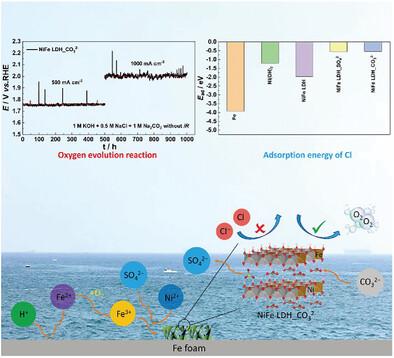当前位置:
X-MOL 学术
›
Adv. Energy Mater.
›
论文详情
Our official English website, www.x-mol.net, welcomes your feedback! (Note: you will need to create a separate account there.)
Layered Double Hydroxides with Carbonate Intercalation as Ultra‐Stable Anodes for Seawater Splitting at Ampere‐Level Current Density
Advanced Energy Materials ( IF 27.8 ) Pub Date : 2024-04-22 , DOI: 10.1002/aenm.202400053 Peng‐Jun Deng 1 , Yang Liu 2 , Huili Liu 1 , Xiaona Li 1 , Jiajia Lu 1 , Shengyu Jing 3 , Panagiotis Tsiakaras 4
Advanced Energy Materials ( IF 27.8 ) Pub Date : 2024-04-22 , DOI: 10.1002/aenm.202400053 Peng‐Jun Deng 1 , Yang Liu 2 , Huili Liu 1 , Xiaona Li 1 , Jiajia Lu 1 , Shengyu Jing 3 , Panagiotis Tsiakaras 4
Affiliation

|
Owing to the presence of a substantial concentration of chlorine in seawater, the anode still faces severe chlorine corrosion, especially the water splitting operated at high current densities. Herein, the cost‐effective and scalable NiFe layered double hydroxides with carbonate intercalation (named as NiFe LDH_CO3 2− ) are synthesized utilizing the etching‐hydrolysis and ion exchange strategies under ambient conditions. Experimental findings demonstrate that NiFe LDH_CO3 2− shows excellent stability at 500 and 1000 mA cm−2 for 1000 h under alkaline simulated seawater. Additionally, a two‐electrode system offers great stability at current densities ranging from 100 to 1000 mA cm−2 over a duration of 400 h in alkaline seawater. This remarkably catalytic stability can be ascribed to the etching‐hydrolysis and carbonate intercalation strategies. The etching‐hydrolysis strategy leads to an integrated electrode for the catalyst‐carrier, enhancing the adhesion between them, and retarding hence the divorce of catalysts from the carrier. Theoretical calculations suggest that the carbonate intercalation weakens the adsorbability of chlorine on catalysts and hinders the coupling of metal atoms with chlorine, thereby impeding the anode corrosion caused by chlorine and improving catalytic stability. More importantly, this strategy has been extended to the preparation of other layered double hydroxides with carbonate intercalation.
中文翻译:

具有碳酸盐插层的层状双氢氧化物作为超稳定阳极用于安培级电流密度下的海水分裂
由于海水中存在高浓度的氯,阳极仍然面临严重的氯腐蚀,特别是在高电流密度下操作的水分解。本文中,具有成本效益且可扩展的具有碳酸盐插层的 NiFe 层状双氢氧化物(命名为 NiFe LDH_CO3 2− )是在环境条件下利用蚀刻水解和离子交换策略合成的。实验结果表明 NiFe LDH_CO3 2− 在 500 和 1000 mA cm 下表现出出色的稳定性−2 碱性模拟海水下1000小时。此外,双电极系统在 100 至 1000 mA cm 的电流密度范围内具有出色的稳定性−2 在碱性海水中持续时间超过 400 小时。这种显着的催化稳定性可归因于蚀刻水解和碳酸盐插层策略。蚀刻水解策略形成了催化剂载体的集成电极,增强了它们之间的粘附力,从而延缓了催化剂与载体的分离。理论计算表明,碳酸盐插层削弱了氯在催化剂上的吸附能力,阻碍了金属原子与氯的偶联,从而阻止了氯引起的阳极腐蚀,提高了催化稳定性。更重要的是,该策略已扩展到其他具有碳酸盐插层的层状双氢氧化物的制备。
更新日期:2024-04-22
中文翻译:

具有碳酸盐插层的层状双氢氧化物作为超稳定阳极用于安培级电流密度下的海水分裂
由于海水中存在高浓度的氯,阳极仍然面临严重的氯腐蚀,特别是在高电流密度下操作的水分解。本文中,具有成本效益且可扩展的具有碳酸盐插层的 NiFe 层状双氢氧化物(命名为 NiFe LDH_CO



























 京公网安备 11010802027423号
京公网安备 11010802027423号